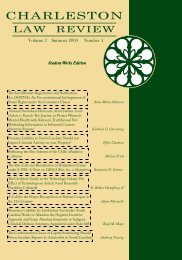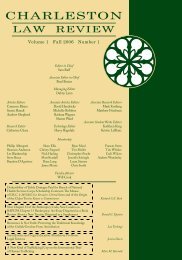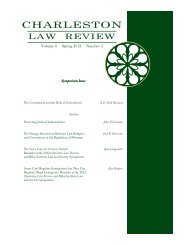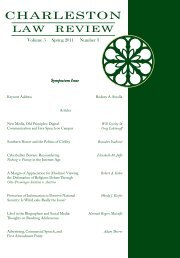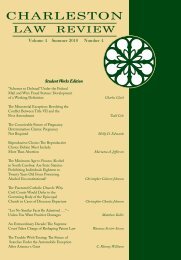Volume 5 Winter 2011 Number 2 - Charleston Law Review
Volume 5 Winter 2011 Number 2 - Charleston Law Review
Volume 5 Winter 2011 Number 2 - Charleston Law Review
You also want an ePaper? Increase the reach of your titles
YUMPU automatically turns print PDFs into web optimized ePapers that Google loves.
CHARLESTON LAW REVIEW [<strong>Volume</strong> 5II. LEARNING STYLES: A BRIEF OVERVIEWAs law professors strive to teach more effectively and toenhance their students’ ability to learn, discussion has focused onthe notion that they must understand and teach to theirstudents’ learning styles. Thus, just as some groups within thelegal profession are exploring the social, cultural, and economicmilieu of today’s law students, 11 some are also focusing onwhether intrinsic differences dictate how individual studentslearn. Indeed, many within the legal academy appear to haveembraced the notion that such differences exist and the parallelnotion that law school educators should discover and teach tothese learning styles. 1211. See, e.g., Joan Catherine Bohl, Generations X and Y in <strong>Law</strong> School:Practical Strategies for Teaching the “MTV/Google” Generation, 54 LOY.L.REV.775 (2008) (exploring the technological experiences of today’s law students andstrategies for incorporating those experiences into meaningful classroomdynamics); Gerald F. Hess, Listening to Our Students: Obstructing andEnhancing Learning in <strong>Law</strong> School, 31 U.S.F. L. REV. 941 (1997) (exploring howdiverse law students perceive their law school learning experiences); Alice K.Dueker, Diversity and Learning: Imagining a Pedagogy of Difference, 19 N.Y.U.REV. L.&SOC. CHANGE 101 (1991–1992); Joanne Ingham & Robin A. Boyle,Generation X in <strong>Law</strong> School: How These <strong>Law</strong> Students are Different from ThoseWho Teach Them, 56 J. LEGAL EDUC. 281 (2006) (presenting the results of amulti-year study of law students’ and law faculty’s learning styles); 18 THESECOND DRAFT: BULL. OF THE LEGAL WRITING INST. (Dec. 2003) (containingseveral articles devoted to teaching the current generation of law students).12. See generally Robin A. Boyle & Rita Dunn, Teaching <strong>Law</strong> StudentsThrough Individual Learning Styles, 62 ALB. L.REV. 213 (1998) [hereinafterBoyle & Dunn, Teaching <strong>Law</strong> Students] (noting the burgeoning interest inlearning styles in legal education); Robin Boyle, Jeffrey Minneti & AndreaHonigsfeld, <strong>Law</strong> Students Are Different from the General Population: EmpiricalFindings Regarding Learning Styles, 17 PERSP.: TEACHING LEGAL RES. &WRITING 153 (2009); Eric A. DeGroff & Kathleen A. McKee, Learning Like<strong>Law</strong>yers: Addressing the Differences in <strong>Law</strong> Student Learning Styles, 2006 BYUEDUC. &L.J. 499 (2006); Jacobson, A Primer on Learning Styles, supra note 9;M. H. Sam Jacobson, Learning Styles and <strong>Law</strong>yering: Using Learning Theory toOrganize Thinking and Writing, 2 J. ASS’N LEGAL WRITING DIRECTORS 27 (Fall2004); M. H. Sam Jacobson, How <strong>Law</strong> Students Absorb Information:Determining Modality in Learning Style, 8 LEGAL WRITING: J. LEGAL WRITINGINST. 175 (2002) [hereinafter Jacobson, How <strong>Law</strong> Students Absorb Information];Eileen B. Cohen, Teaching Legal Research to a Diverse Student Body, 85 LAWLIBR. J. 583 (1993); 22 THE SECOND DRAFT: BULL. OF THE LEGAL WRITING INST.(Spring 2008) (containing articles focused on “teaching to different learningstyles”).138



